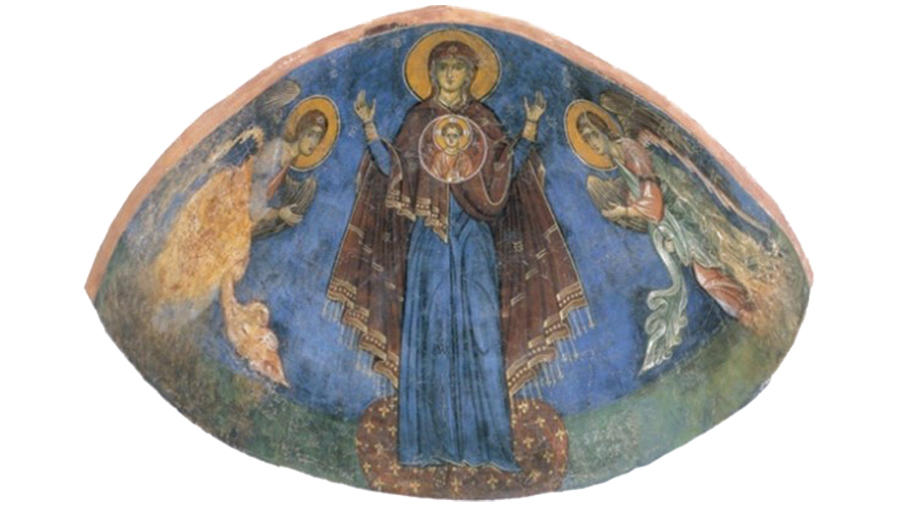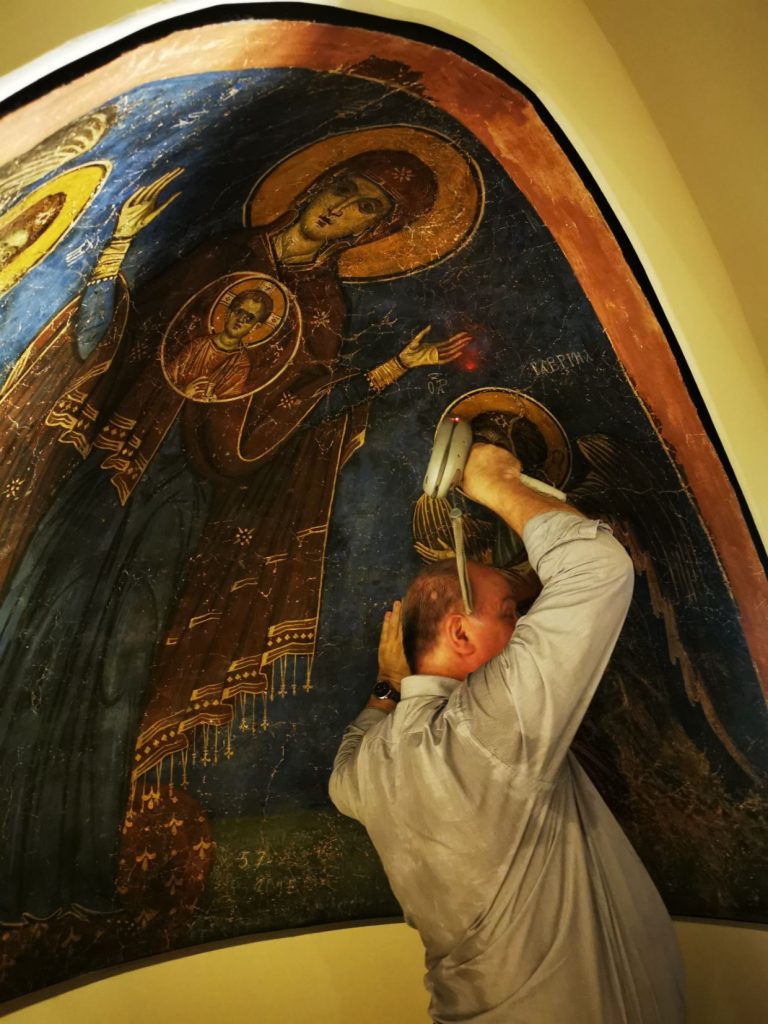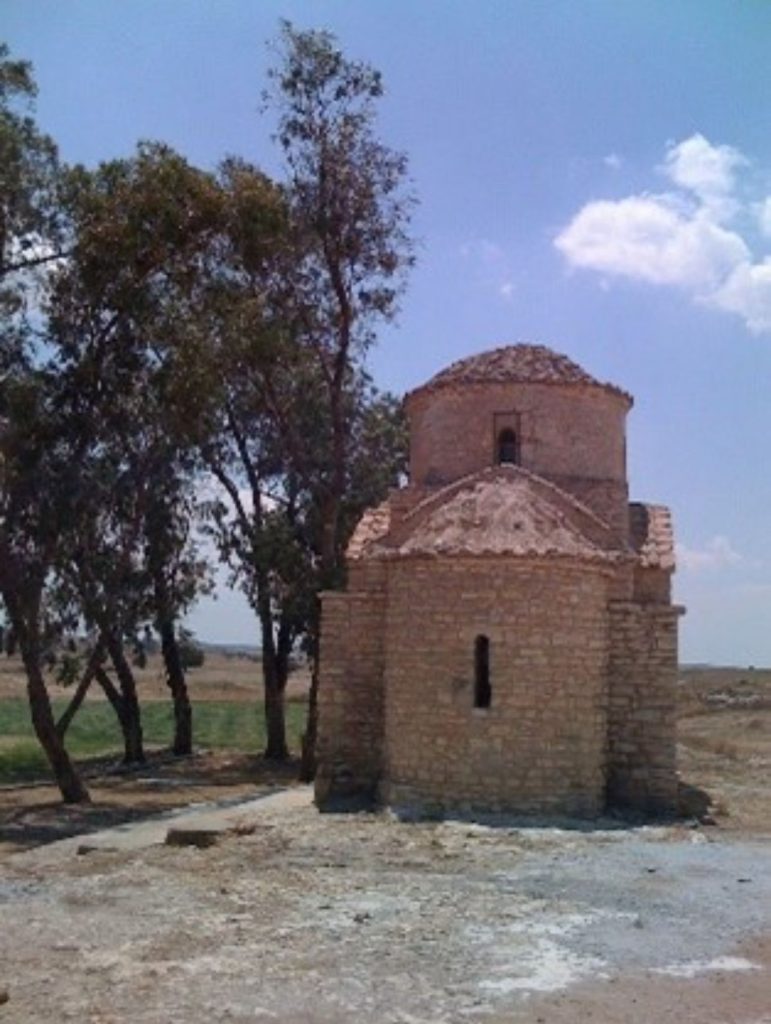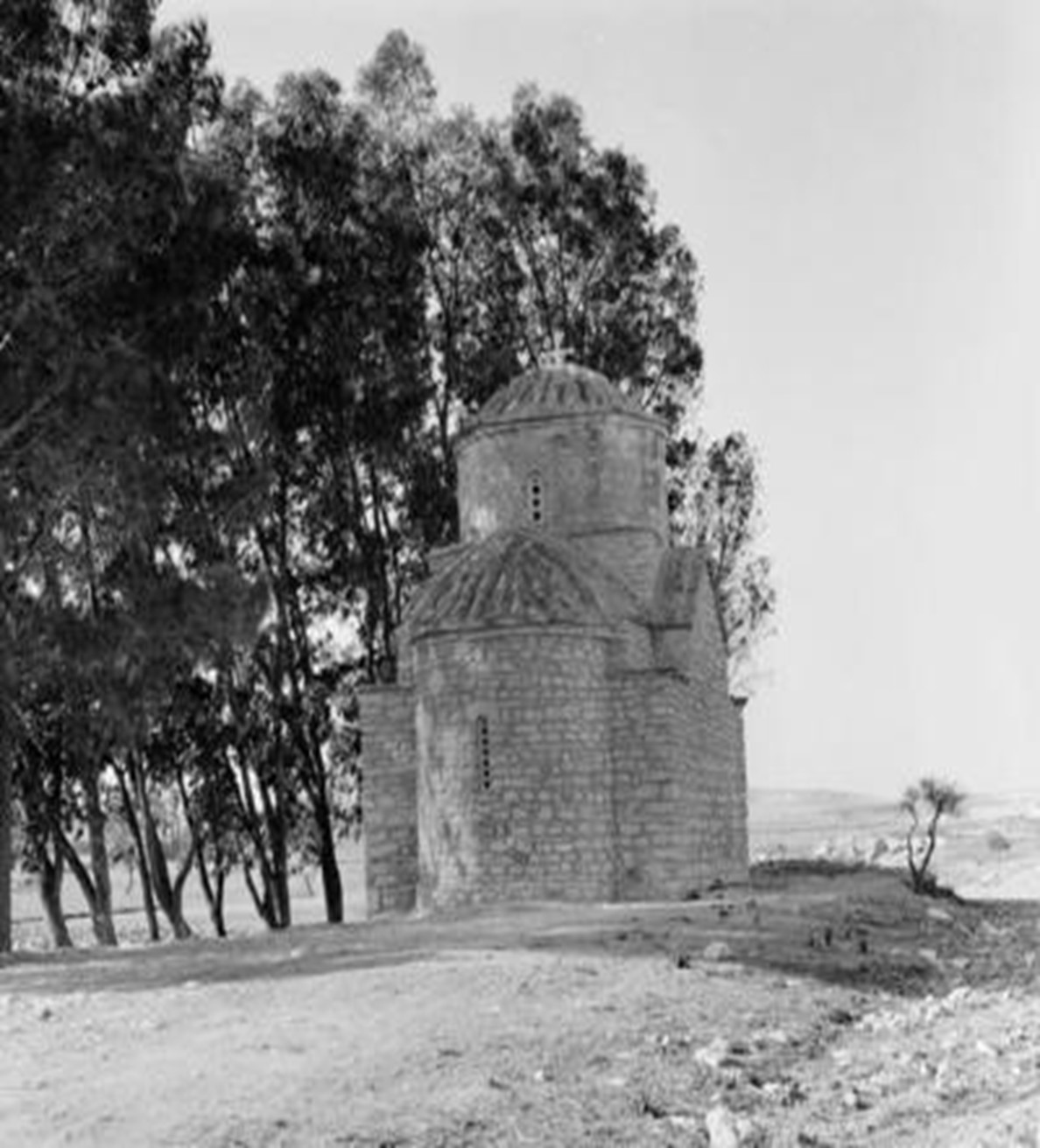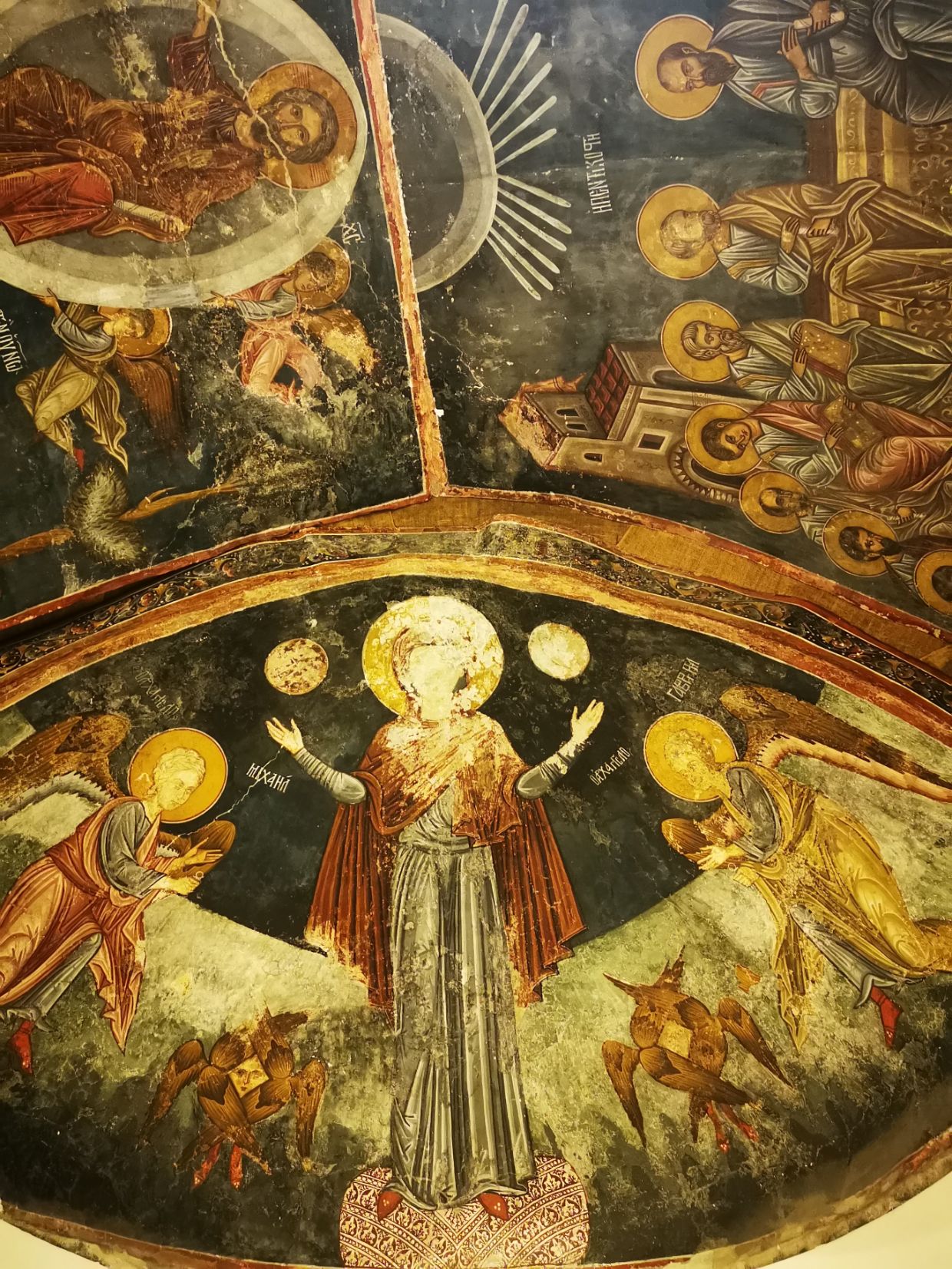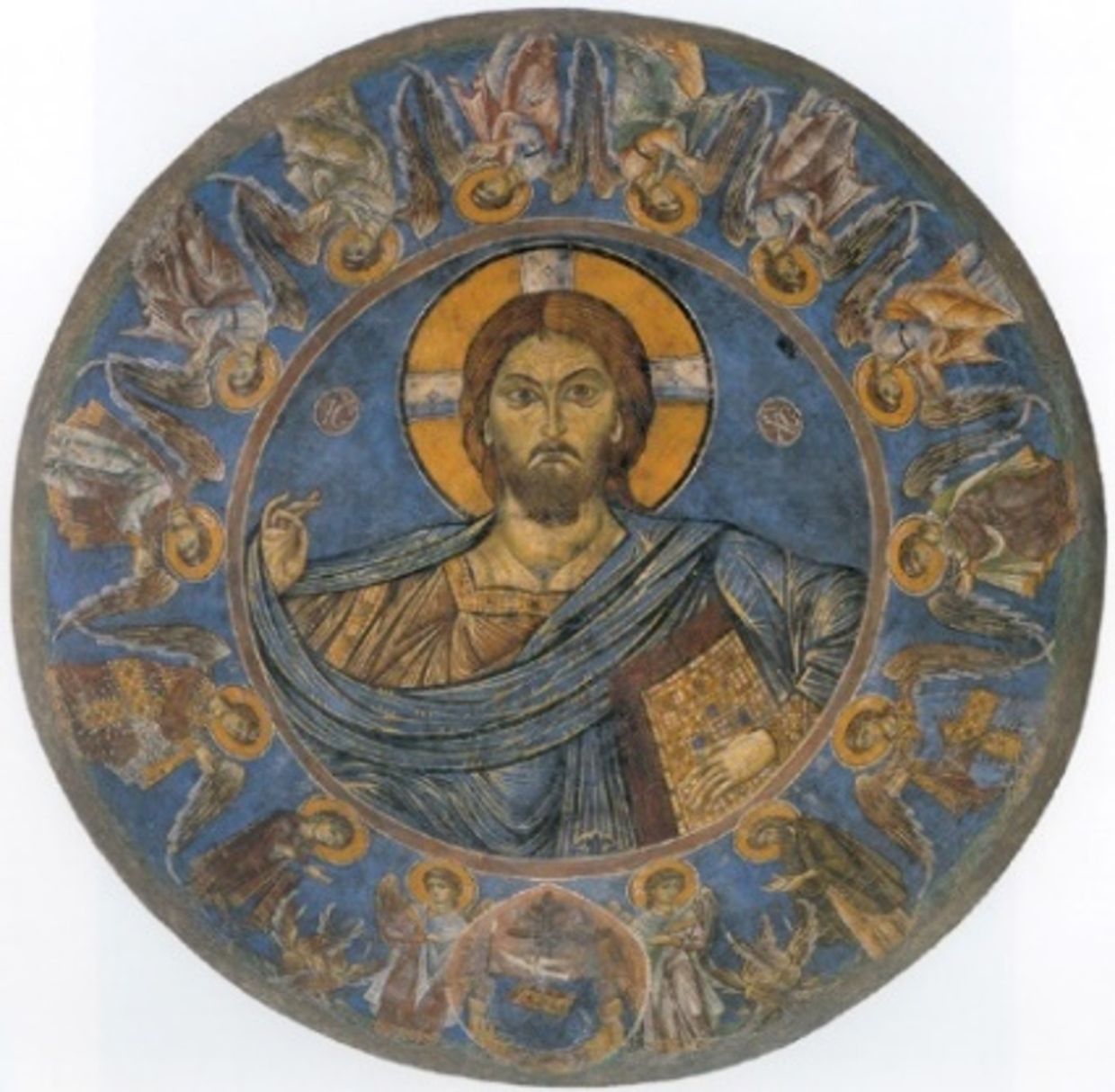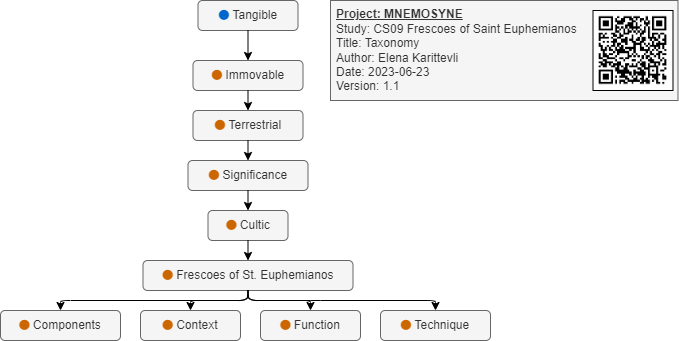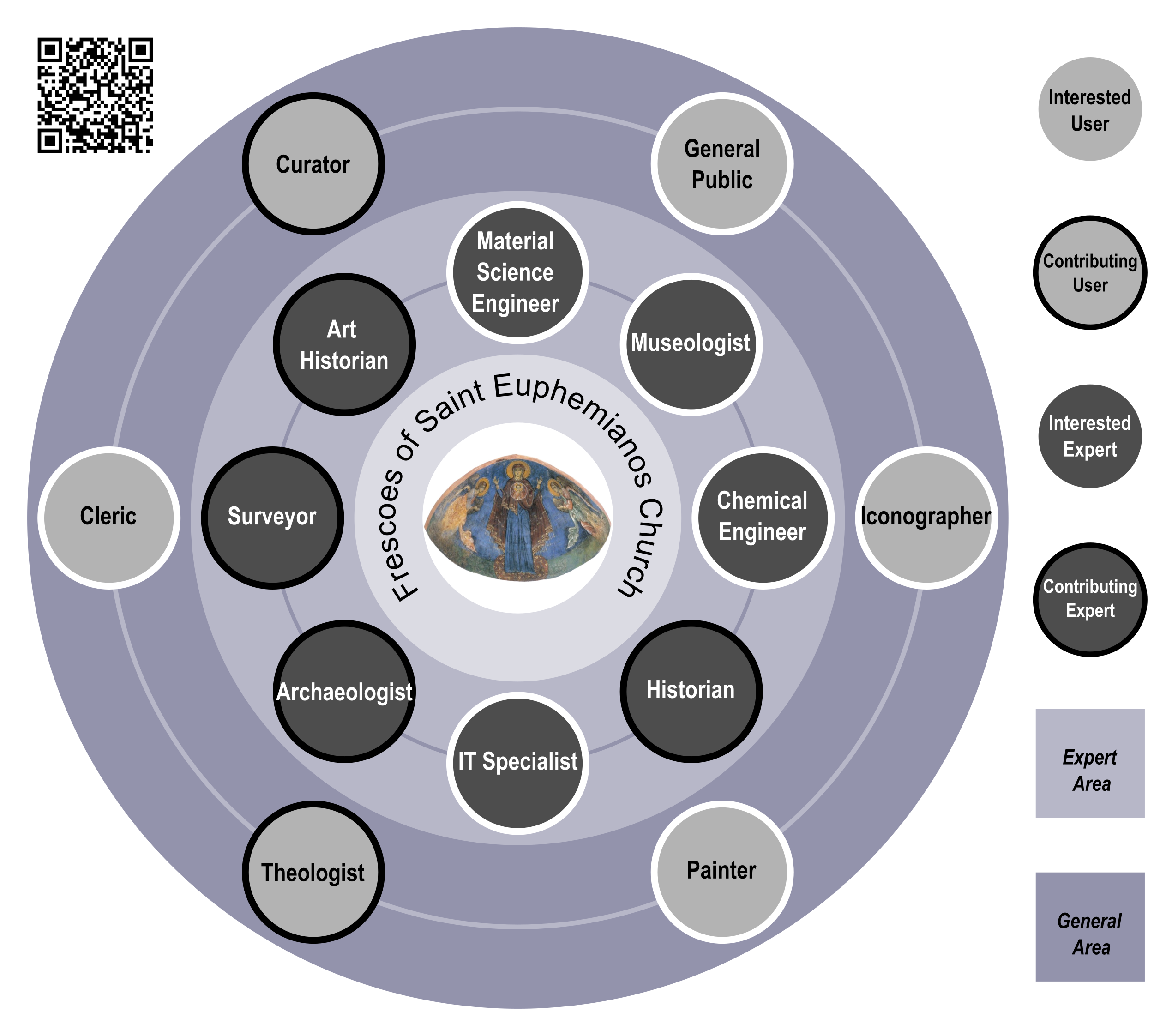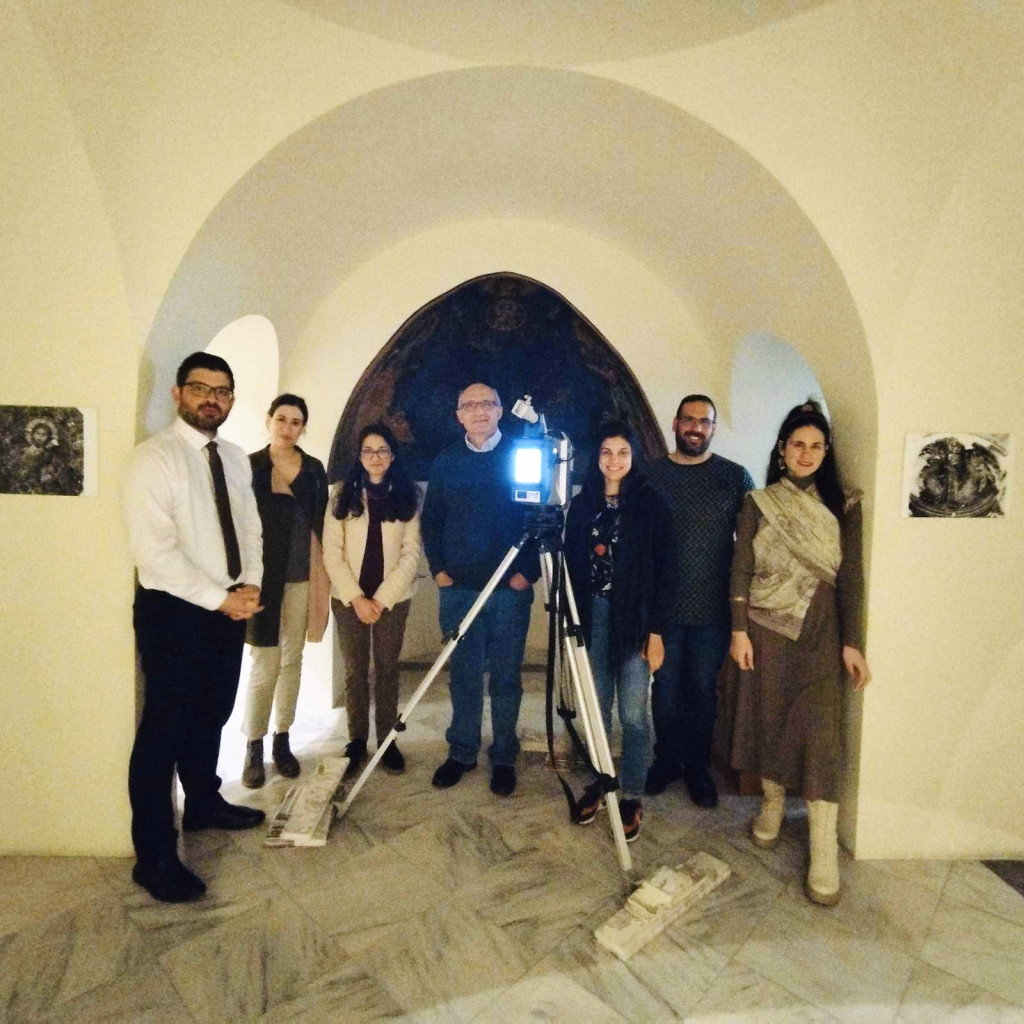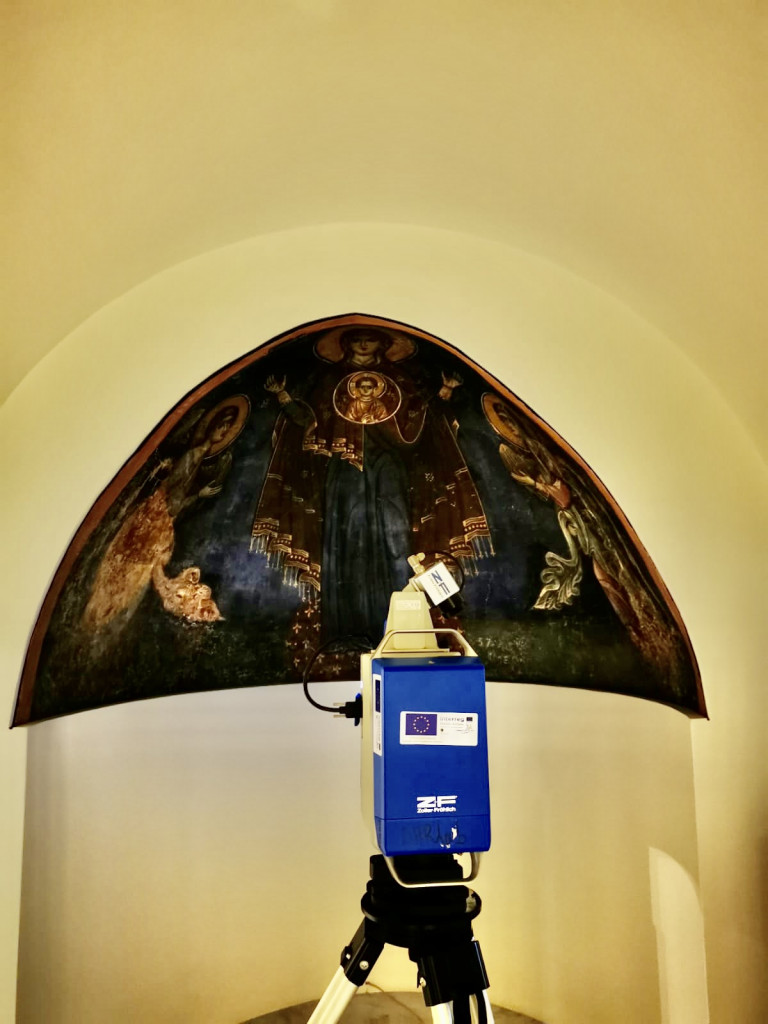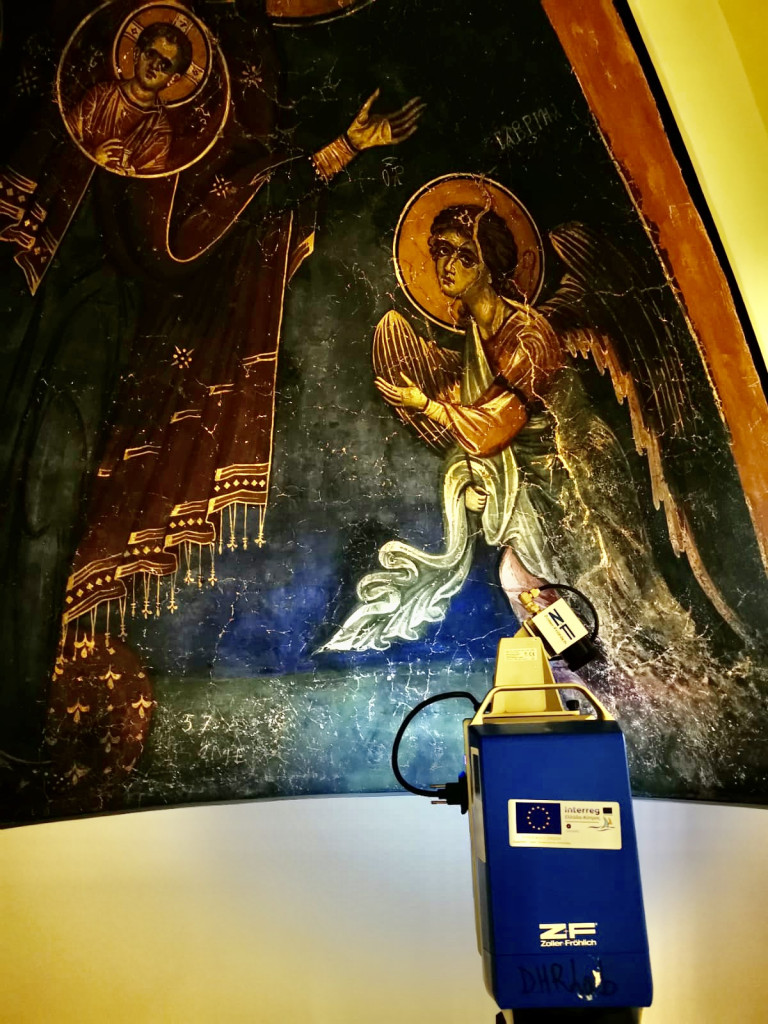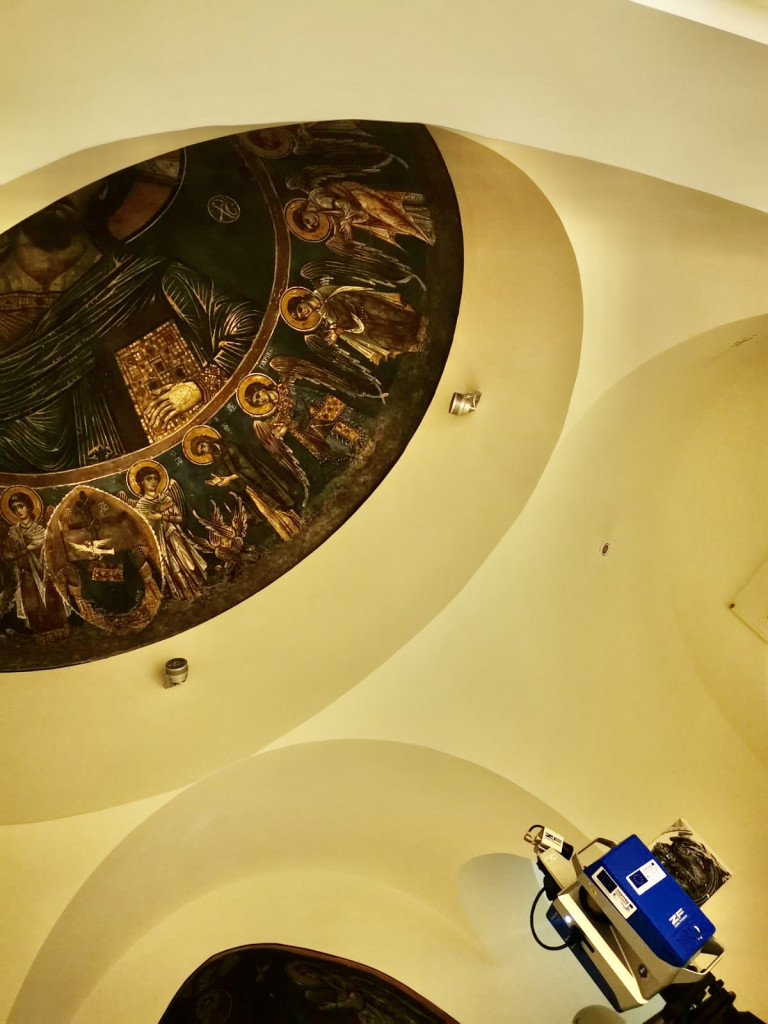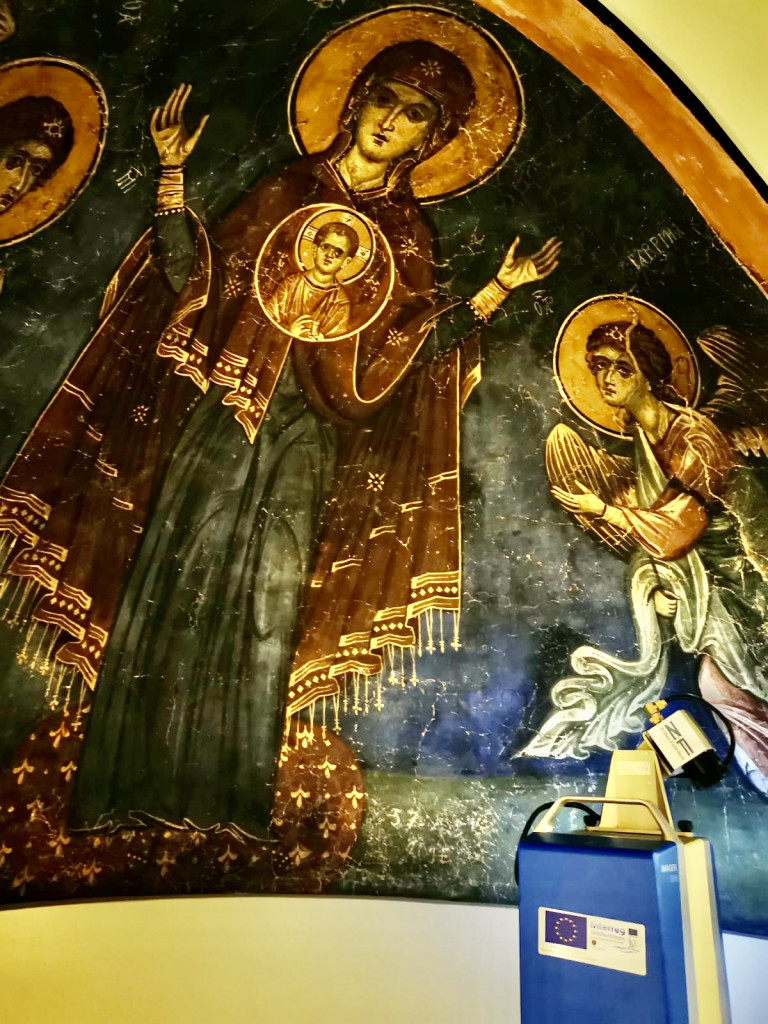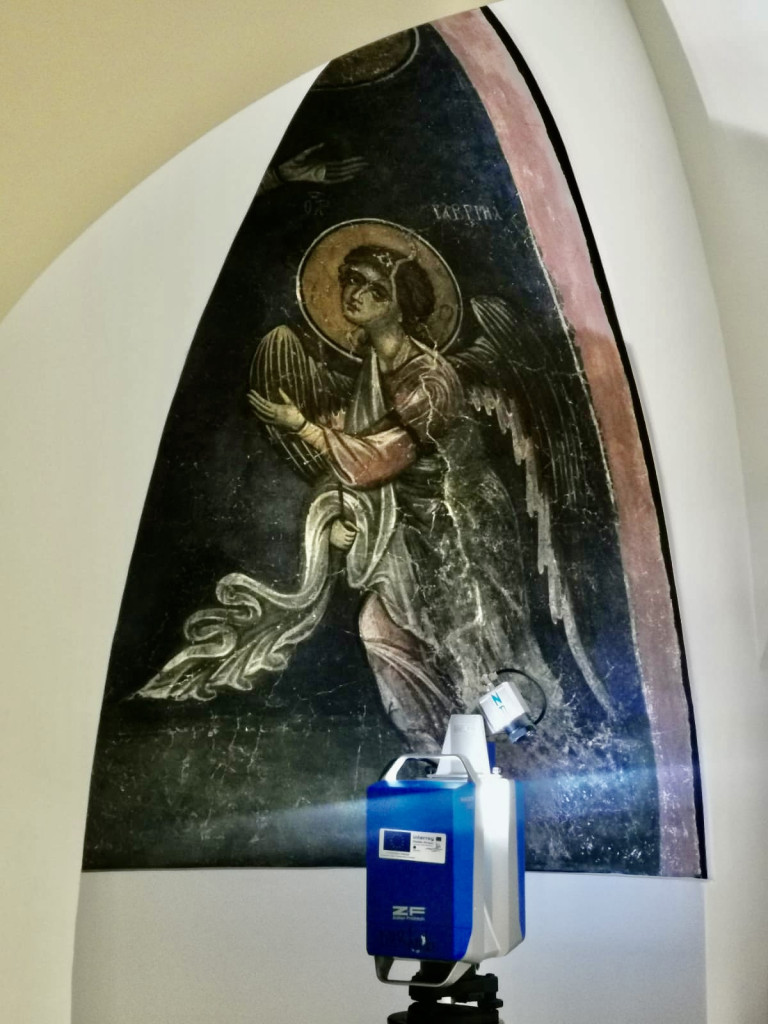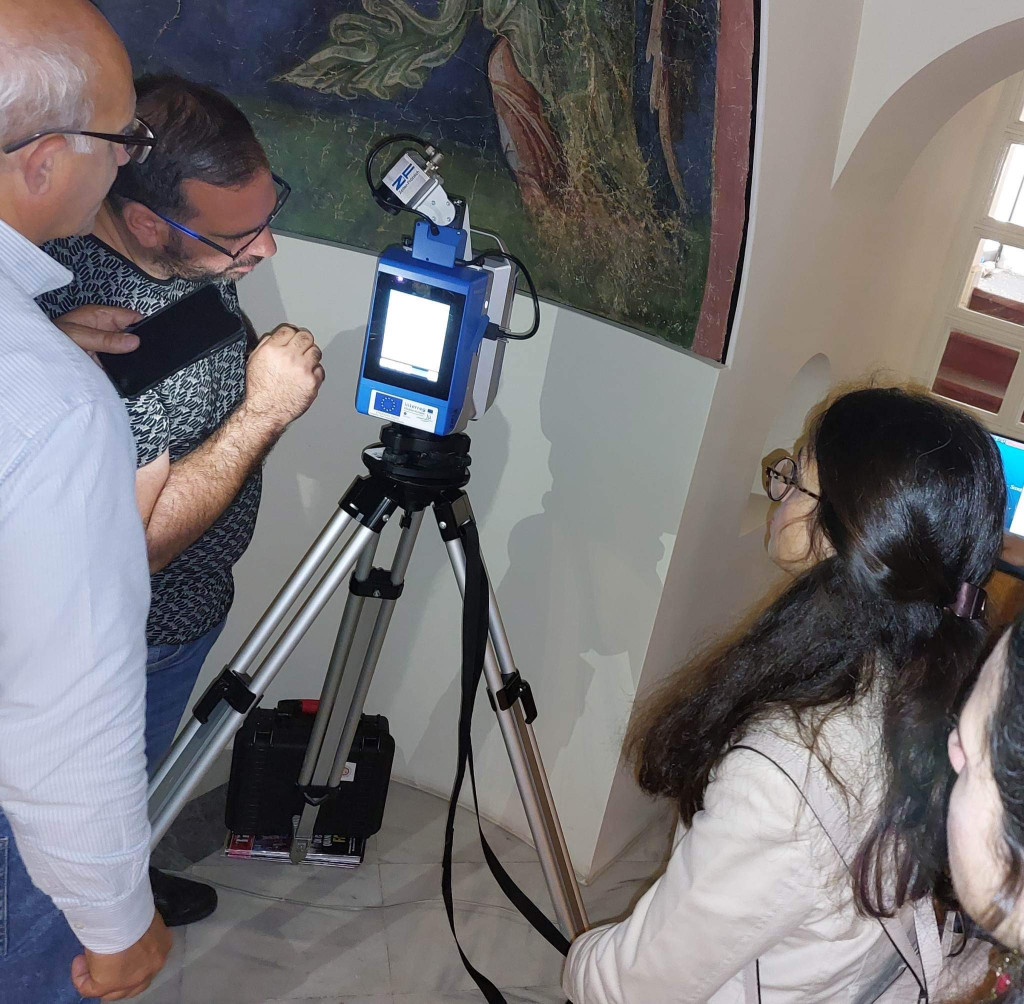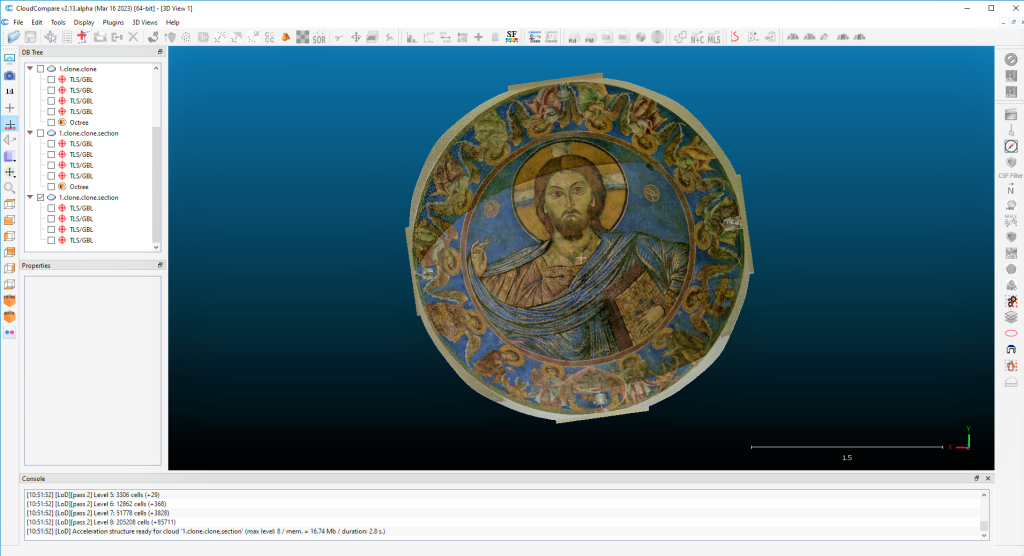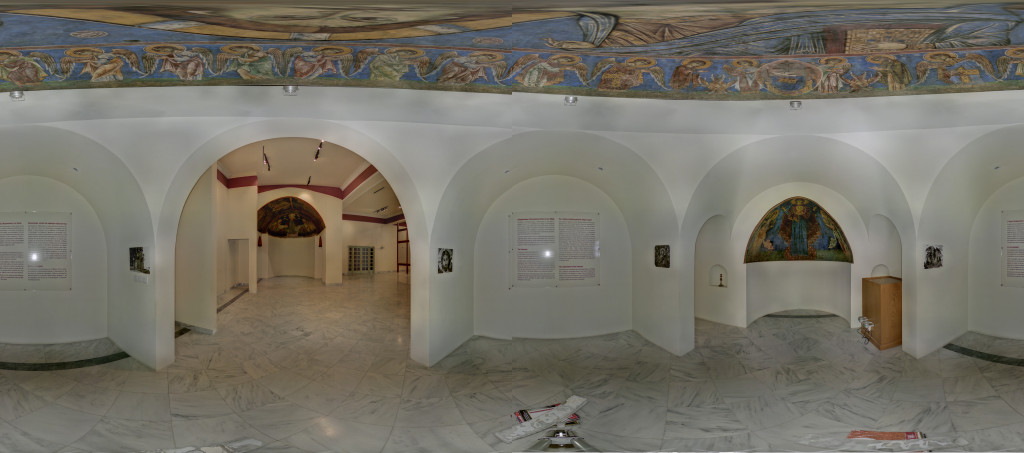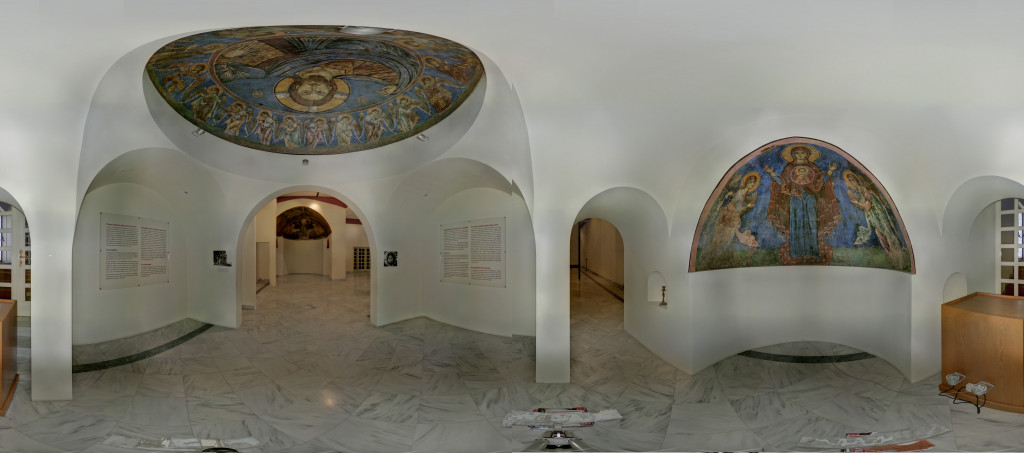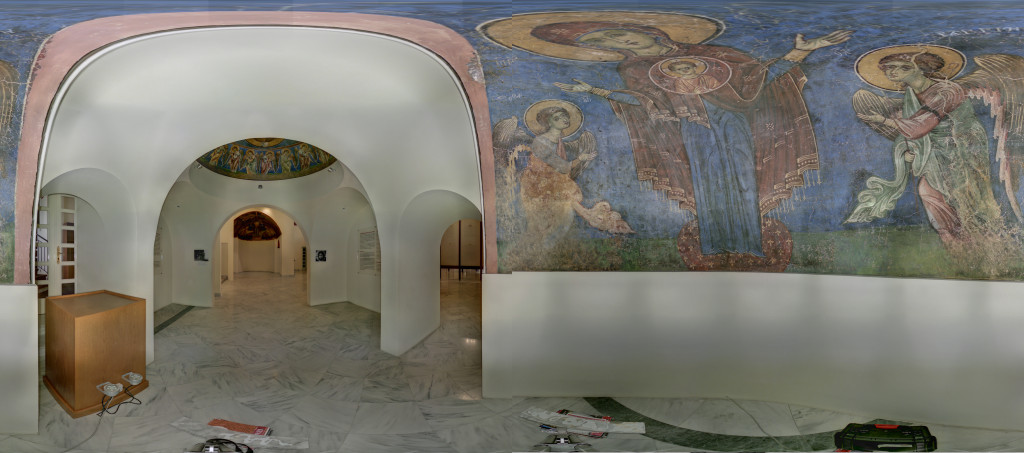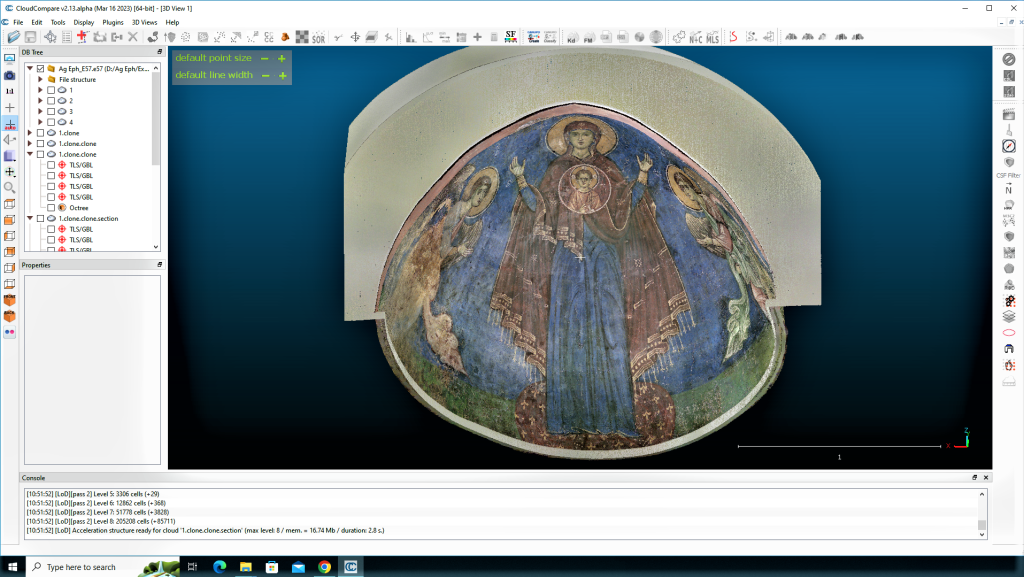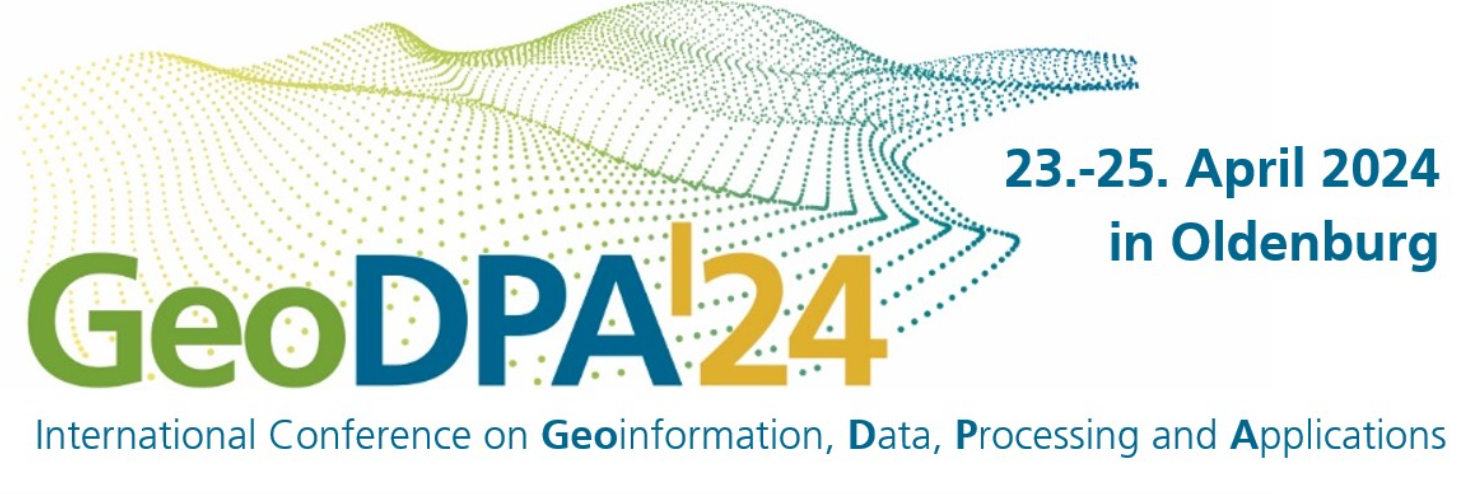1. Introduction
The Church of Saint Euphemianos or Themonianos is a small, single-room, medieval chapel, surrounded by eucalyptus about 3klm southwest of the village of Lysi in the district of Ammochostos/Famagusta district of Cyprus. It is a very small, single-dome stone building with dimensions 7.5 x 3.5m (without the arch). According to the inscription on the bottom of the arch, which was destroyed by looters, is indicated that the church was dedicated by Monk Lavrentios and Abbot of St. Andronikos Monastery, to St. Euphemianos (Themonianos), a local saint. The interior is decorated with frescoes, which have suffered great damage because of the moisture. Thus, in 1972 maintenance was undertaken by the Department of Antiquities of Cyprus, completed a year before the Turkish invasion of 1974.
The dome of the church is decorated with a fresco depicting the Christ Pantocrator. Surrounding the figure of Christ is a double row of angels moving towards the Hetoimasia (the preparation of the throne of the Second Coming of Christ). The Virgin Mary leads one line of the angels to the throne, while John the Baptist leads to the other. In the other fresco of the apse, the Virgin is depicted flanked by two archangels, Gabriel and Michael, with a medallion on her breast of the infant Christ, symbolizing the Incarnation of Christ. A big part of the figure of the archangel Michael has been destroyed due to humidity, whereas the face and figure of the archangel Gabriel remain in very good condition. The frescoes date back to the 13th century and they are typical examples of the Maniera Cypria, the Cypriot painting of the 13th century reflecting the artistic symbiosis between two worlds, East and West in the artworks of the period.
During the 1980s, apart from icons, mosaics and frescoes which had been traumatically detached from their “natural habitat” began to appear in the international art market. The first case of organized looting that occurred after the cases of the frescoes of the church of Antiphonitis and the mosaics of Panagia Kanakaria, was that of the frescoes of Saint Euphemianos church. The frescoes of Saint Euphemianos church were forcibly removed by professional looters and were cut into 38 pieces. This case serves as evidence of the brutal destruction of the cultural heritage in the occupied part of Cyprus by the Turkish state officials who participated in and supported the looting. The 38 fragments were bought in 1983 by the Houston-based Menil Foundation in agreement with the Greek Orthodox Church of Cyprus. With the consent of Archbishop Chrysostomos I, a small chapel museum was built in Houston, where the frescoes were presented after their conservation (1984-1988). In 1992 the agreement signed by the Church of Cyprus and the Menil Foundation specified that the Foundation would take care of the frescoes and cover the ongoing costs of conservation in exchange for the right to present the frescoes for 20 years, concluding in February 2012. The frescoes were repatriated on March 16, 2012, with the valuable help of the Archbishop of Cyprus Chrysostomos II and the authorities of the Republic of Cyprus. They are temporally exhibited at the Byzantine Museum of the Archbishop Makarios III Foundation, with the aim of returning them to their birthplace after resolving the Cyprus Question.
For the holistic documentation of the frescoes of Saint Euphemianos, a conceptual model of data was created which divides the different types of data needed for the record of a cultural heritage object into classification categories. The general taxonomic system was developed under the MNEMOSYNE project (H2020 ERA Chair) and categorizes the frescoes within the classes, for example, Tangible and Immovable, indicating the type of the object. Furthermore, the intangible information of the object gives information on the past and current location of the frescoes, the period of production, the legal owner of the frescoes etc. This data offers important explanations and knowledge regarding the history of the frescoes. The collected information supports contextual knowledge redistribution and preventive conservation through awareness of the object’s heritage significance. The holistic documentation of the frescoes is important for piecing together their history, which is achieved by recording all of the related information within the same system.
The cutting, stealing and illegal export of the frescoes demonstrates the extent of the violent destruction of Cyprus’ cultural heritage by Turkish illicit antiquities dealers in the Turkish-occupied part of the island and by the Turkish occupation army that was actively supporting and even partaking in the looting of churches and monasteries, and medieval monuments. For this reason, many hold the hope to one day not only return to their occupied lands but to also see looted artefacts returned to their rightful place of origin. To this end, the ERA Chair team members work toward a set of objectives, including digitizing the two frescoes located in the Byzantine Museum in Nicosia to perform a digital reunification with the 3D model of the church to provide an as close as possible authentic setting for the murals. Furthermore, written sources (e.g. newspapers) and photographs of the Church before the frescoes were forcibly removed in 1984 are to be collected via crowdsourcing and subsequently digitized. The research results are to be disseminated to the international community (e.g. Europeana) to raise awareness of the violent destruction of Cyprus’ cultural heritage.
Estimation of Complexity & Quality
The following radial charts are base on the based on the EU 3D Study/VIGIE 2020/654
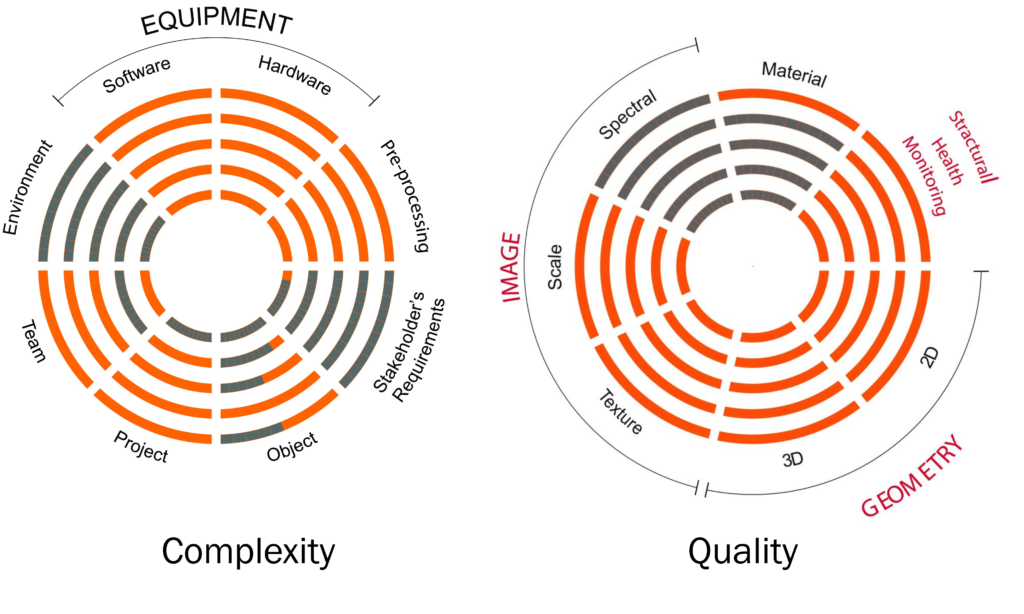
7. Bibliography
- Aloupi, E., Karydas, A. G., & Paradellis, T. (2000). Pigment Analysis of Wall Paintings and Ceramics from Greece and Cyprus. The Optimum Use of X-Ray Spectrometry on Specific Archaeological Issues. 29, 18–24.
- Caggiani, M. C., Cosentino, A., & Mangone, A. (2016). Pigments Checker version 3.0, a handy set for conservation scientists: A free online Raman spectra database. Microchemical Journal, 129, 123–132. https://doi.org/10.1016/J.MICROC.2016.06.020
- Chotzakoglou, C. (2008). RELIGIOUS MONUMENTS IN TURKISH-OCCUPIED CYPRUS, Lefkosia 2008. In Museum of the Holy Monastery of Kykkos. Museum on the holy monastery of Kykkos. https://www.academia.edu/3991971/RELIGIOUS_MONUMENTS_IN_TURKISH_OCCUPIED_CYPRUS_Lefkosia_2008
- Clark, R. J. H., & Franks, M. L. (1975). The resonance Raman spectrum of ultramarine blue. Chemical Physics Letters, 34(1), 69–72. https://doi.org/10.1016/0009-2614(75)80202-8
- Department of Antiquities – The Looting of Cultural Heritage in Occupied Cyprus. (n.d.). Retrieved October 26, 2021, http://www.mcw.gov.cy/mcw/DA/DA.nsf/All/5C63072411078AB9C22572750055D67D?OpenDocument
- Fincham, D. (2015). The Rescue, Stewardship, and Return of the Lysi Frescoes by the Menil Foundation. International Journal of Cultural Property, 22(2–3), 301–314. https://doi.org/10.1017/S0940739115000120
- Ganetsos, T., Christ, E., Christopoulou, E., Laskaris, N., & Ganetsos, T. (2020). Pigment identification of two post-byzantine icons of Theodoros Poulakis by PXRF and Raman Spectroscopy: Case study. CHRISTOPOULOU et al SCIENTIFIC CULTURE, 6(2), 65–72. https://doi.org/10.5281/zenodo.3785044
- Gulmini, M., Ricciardi, P., Idone, A., Christopoulou, E., Ganetsos, T., & Laskaris, N. (2021). Non-Destructive XRF and Raman Spectroscopy Analysis in Pigment Identification of a Wall Painting of the Painter Non-Destructive XRF and Raman Spectroscopy Analysis in Pigment Identification of a Wall Painting of the Painter Nikiforos Lytras from the Chapel of Agios Georgios, Haidari, Athens. https://doi.org/10.5923/j.archaeology.20210901.02
- Menil collection is to return Frescoes to Cyprus. (2011). The New York Times. https://www.nytimes.com/2011/09/24/arts/design/menil-collection-is-to-return-frescoes-to-cyprus.html?_r=1&ref=design
- Returning from Texas at Age 700. (2011). Wall Street Journal. https://www.wsj.com/articles/SB10001424053111903703604576587072924927678
- H2020 ERA chair. (n.d.). Retrieved August 10, 2022, from http://erachair-dch.com/about/
- Kakoulli, I., & Fischer, C. (n.d.). An Innovative Noninvasive and Nondestructive Multidisciplinary Approach for the Technical Study of the Byzantine Wall Paintings in the Enkleistra of St. Neophytos in Paphos, Cyprus — Dumbarton Oaks. Retrieved August 10, 2022, from https://www.doaks.org/research/byzantine/project-grants/kakoulli-and-fischer-2008-2009
- Katsaros, T., Ganetsos, T., & Ganetsos, T. (2012). Raman Characterization of Gemstones from the Collection of the Byzantine & Christian Museum. Archaeology, 2012(2), 7–14. https://doi.org/10.5923/j.archaeology.20120102.01 Kline, Th. R. (2014). Protecting the Cultural Property of Cyprus, Now and in the Future: Opportunities for Broader Collaboration. In Protecting the Cultural Heritage of Cyprus:

